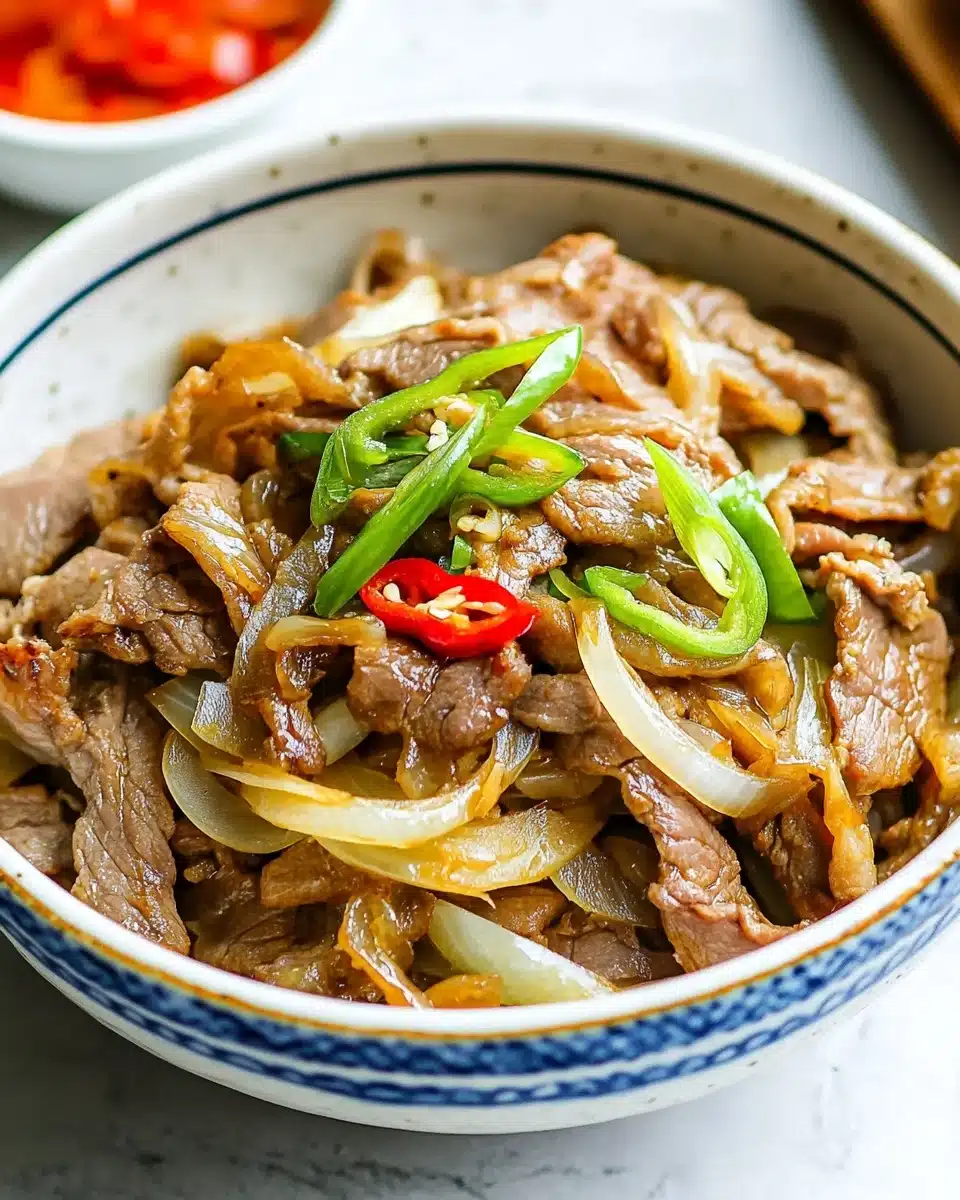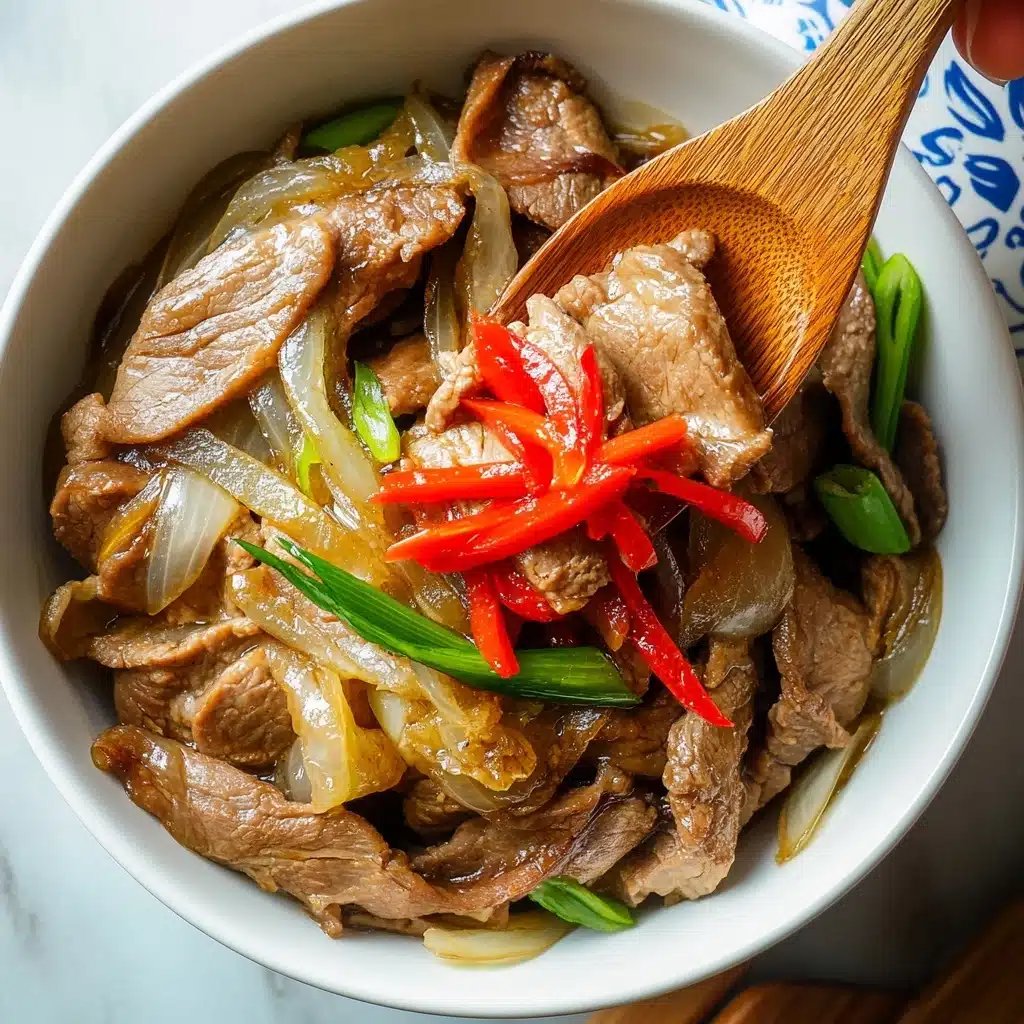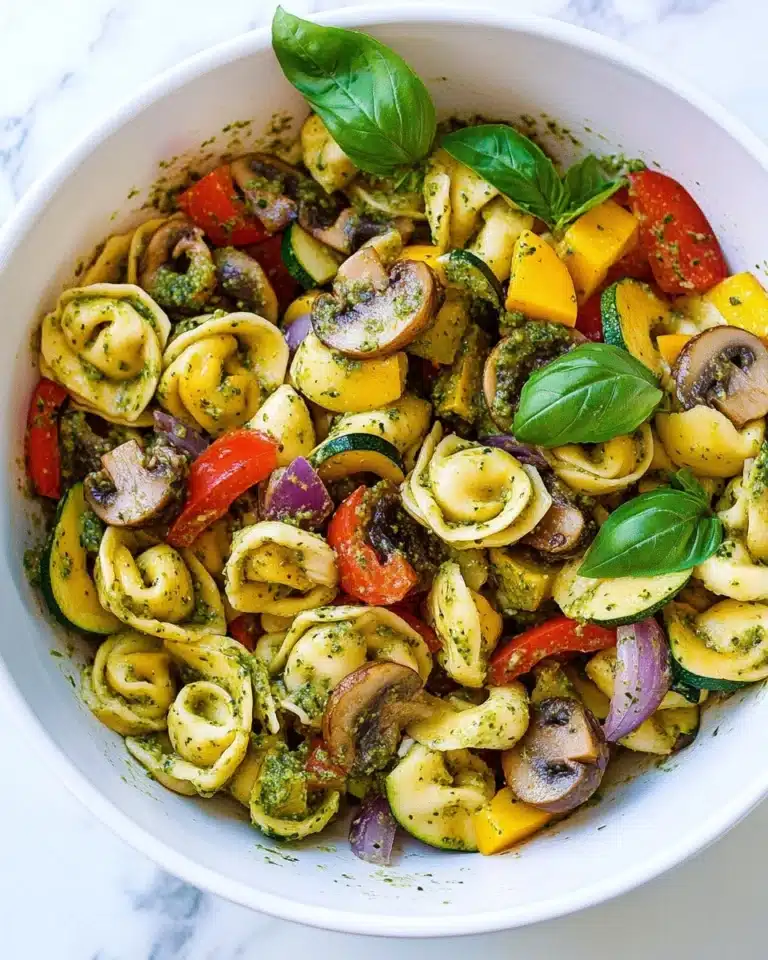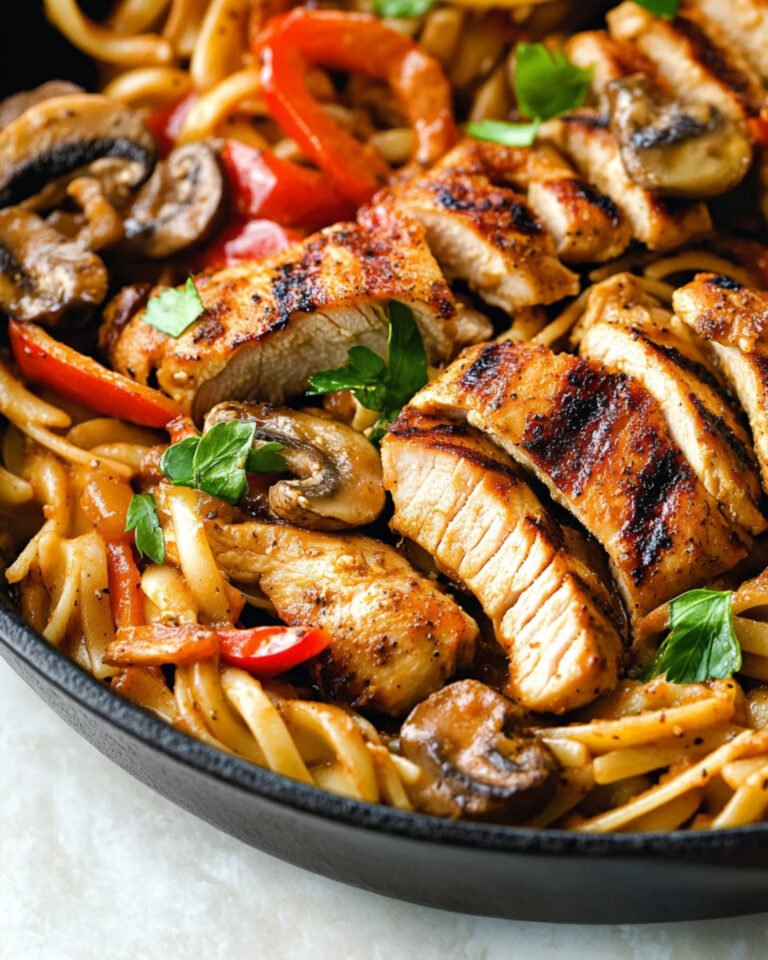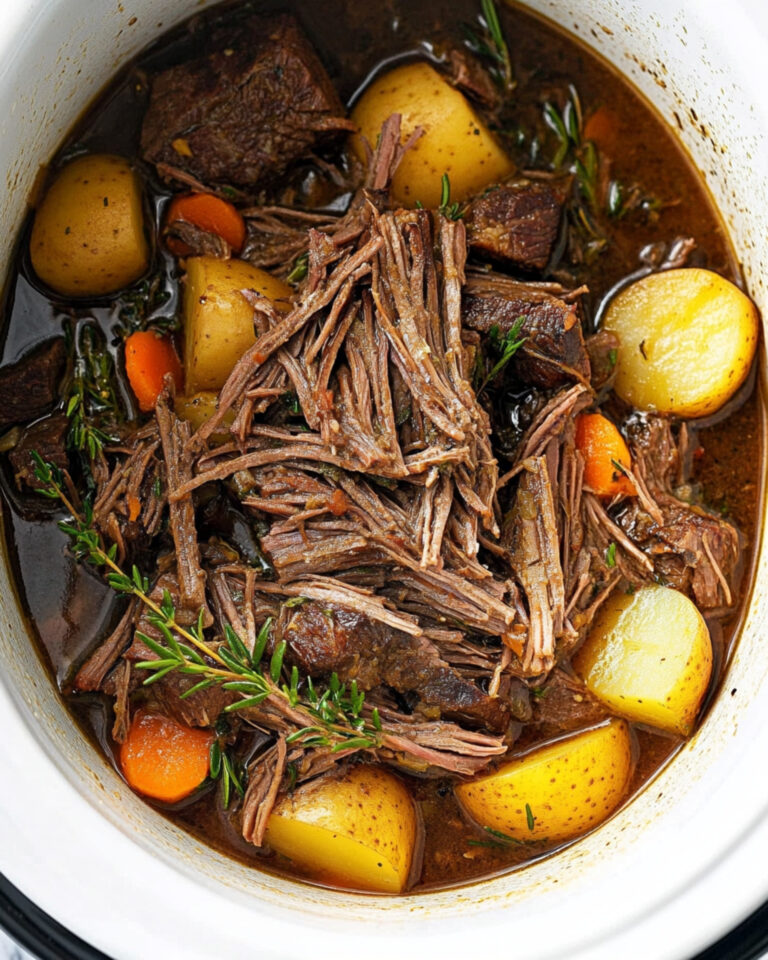I absolutely love how Gyudon (Japanese Beef Rice Bowl) Recipe captures the heart of home cooking in a bowl. It’s simple, comforting, and packed with juicy thinly sliced beef simmered in a savory-sweet broth that just hugs the rice perfectly. Whether you’re in for a quick weekday dinner or craving some cozy Japanese soul food, this recipe really hits the spot every time.
When I first tried making Gyudon at home, I was amazed at how just a handful of ingredients could create such a rich and satisfying dish. What I find especially great is how easy it is to customize, so if you’re looking for a quick meal that still feels special, this Japanese Beef Rice Bowl recipe is definitely worth trying. Plus, cooking it yourself means you can control the flavors and make it as light or as rich as you like.
Why You’ll Love This Recipe
- Quick and Easy: You’ll have a warm meal ready in about 20 minutes without any complicated steps.
- Authentic Flavor: The balance of dashi, mirin, and soy sauce delivers that classic Japanese taste you crave.
- Versatile Ingredients: You can easily swap sauces and adjust sweetness according to your preference.
- Crowd-Pleaser: My family goes crazy for this, and I bet yours will too once you try it!
Ingredients You’ll Need
This Gyudon (Japanese Beef Rice Bowl) recipe is all about a few fresh ingredients and a well-balanced sauce. Using quality thinly sliced beef and real dashi makes a huge difference here, so keep an eye out for those at your local Asian market or grocery store.
- Onion: Slicing it thin lets it cook quickly and soften into the broth, adding sweetness and texture.
- Green onion/scallion: A fresh garnish that adds color and a bit of mild sharpness.
- Thinly sliced beef (ribeye is great): Freezing the beef slightly before slicing helps you get nice, even thin pieces.
- Dashi (Japanese soup stock): This is the heart of the broth; whether you use powder, packets, or homemade, it adds umami depth.
- Sake: Adds subtle flavor—if you don’t drink alcohol, dry sherry or even water work as a substitute.
- Mirin: Sweet cooking rice wine, or a mix of sake and sugar as alternatives, gives a nice sweetness and gloss.
- Soy sauce: The salty-savoury backbone of the broth.
- Sugar: Balance that savory sauce with a pinch of sweetness to taste.
- Cooked Japanese short-grain rice: Essential for the authentic donburi experience—sticky, soft, and perfect for soaking up the sauce.
- Pickled red ginger (beni shoga or kizami beni shoga): A classic garnish that cuts through the richness with tangy brightness.
Variations
I love giving this Gyudon (Japanese Beef Rice Bowl) recipe my own twist depending on what I have in the fridge or how I’m feeling. Don’t be shy to experiment—you can totally make this dish work for you and your family’s tastes.
- Add a beaten egg: For a creamier texture, I usually drizzle a beaten egg over the beef near the end of simmering—makes it feel richer and more luscious.
- Use ground beef: If slicing beef isn’t your thing, ground beef works well for a quicker, fuss-free version.
- Vegetarian version: Swap the dashi for vegan mushroom broth and replace beef with sautéed mushrooms or tofu.
- Add veggies: Sometimes I throw in thinly sliced carrots or shiitake mushrooms for extra nutrition and flavor.
How to Make Gyudon (Japanese Beef Rice Bowl) Recipe
Step 1: Prep Your Ingredients
Start by slicing your half onion thinly—getting those layers separated is key because you want the onion to cook evenly and melt into the broth. Then cut your green onion diagonally into thin slices and set aside for garnish. Remove the thinly sliced beef from the freezer for about 10 minutes so it’s slightly firm; this makes it easier to slice into 3-inch-wide pieces. Small tip: if your meat is too soft, it’s hard to cut thinly and it might tear.
Step 2: Combine Sauce & Simmer
In a large frying pan (don’t turn on the heat just yet), pour in the dashi, sake, mirin, soy sauce, and sugar. Give it a good stir until the sugar dissolves completely. Spread your onion slices evenly in the pan so they’re submerged in the broth, separating the layers as much as possible. Layer the beef slices neatly on top, and try to separate them so each piece cooks evenly.
Step 3: Cook Gently With a Lid
Cover the pan and turn the heat to medium. When the mixture starts to simmer, reduce the heat so it cooks gently with a low simmer. Keep the lid on for 3-4 minutes—this helps the beef stay tender while soaking up that delicious sauce. While it simmers, open the lid once or twice to skim off any scum or excess fat floating on top—it makes a much cleaner broth and nicer final taste.
Step 4: Add Green Onions and Finish
Sprinkle the green onions over the beef and cover the pan again. Let it cook for another minute or so. If you want to add beaten eggs, now’s the time—pour them in gently and cook until just set. This step is entirely optional but trust me, it adds a lovely silky texture.
Step 5: Serve It Up
Scoop two generous servings of hot Japanese short-grain rice into deep donburi bowls. Drizzle some of the simmered sauce over the rice before piling on the beef and onions. Spoon any remaining sauce on top if you like more flavor. Finally, garnish with a good helping of pickled red ginger for that classic tangy contrast. Grab your chopsticks and enjoy that perfect mix of savory, sweet, and umami!
Pro Tips for Making Gyudon (Japanese Beef Rice Bowl) Recipe
- Freeze Beef Slightly for Easier Slicing: I discovered this trick and it really saves time and prevents uneven pieces.
- Skim Fat for Cleaner Flavor: Taking a minute to remove scum during simmering results in a broth that’s savory but not greasy.
- Control Sweetness: Start with 1 tablespoon sugar, then adjust after tasting the broth—you can always add more.
- Don’t Overcook the Beef: Simmer just until the meat turns brown and tender to keep it juicy and flavorful.
How to Serve Gyudon (Japanese Beef Rice Bowl) Recipe
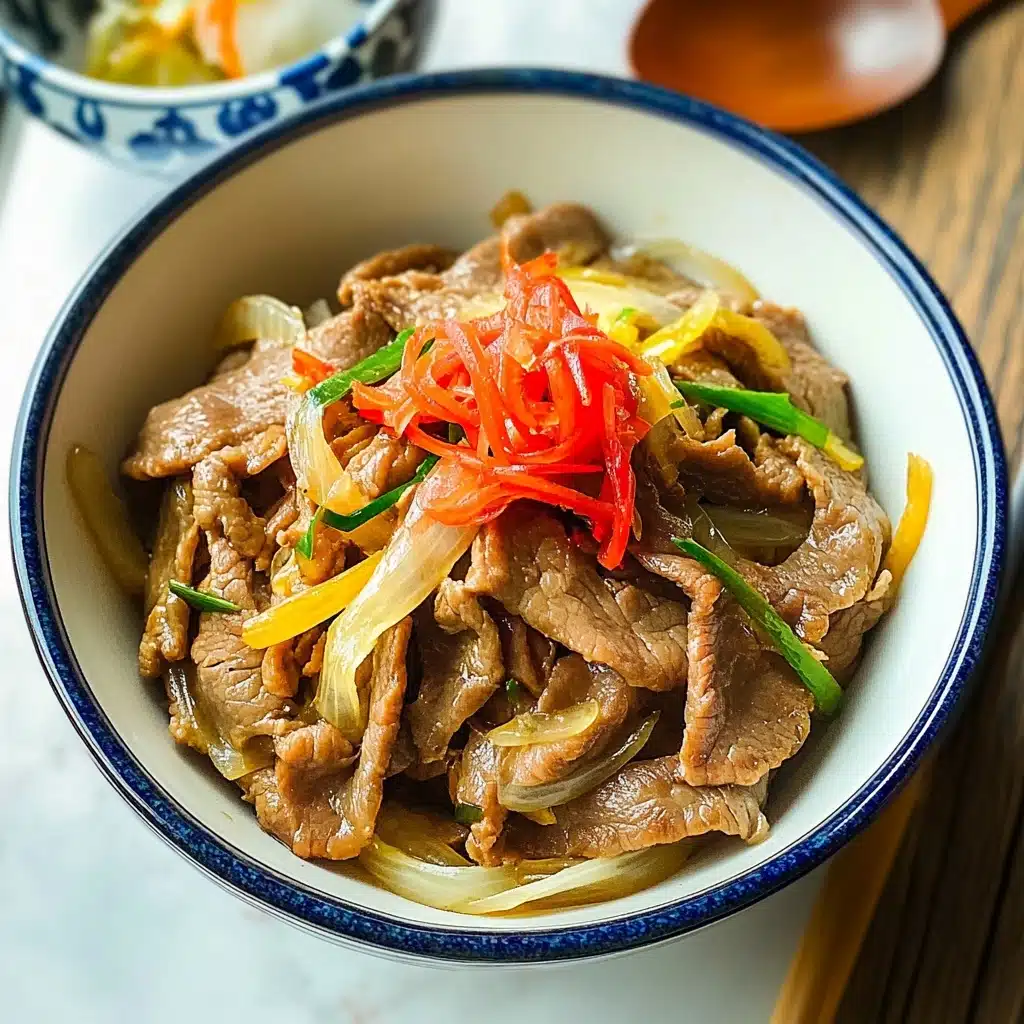
Garnishes
I always top my Gyudon with plenty of pickled red ginger because it adds a punch of acidity that cuts through the rich beef. Sometimes I also sprinkle extra sliced green onions or even a few shreds of nori seaweed for extra depth. If you like spice, a little shichimi togarashi powder is fantastic too.
Side Dishes
To round out the meal, I love pairing this with a crisp cucumber salad or simple miso soup. Steamed or pickled vegetables work nicely, too, to add brightness and contrast. And since Gyudon is really filling, small, light sides keep everything balanced.
Creative Ways to Present
For special occasions, I like serving Gyudon in mini donburi bowls arranged on a wooden tray with decorative leaves underneath—makes it feel truly special. Another idea is layering the beef and onions over sushi rice and adding a soft poached egg on top for an elegant twist.
Make Ahead and Storage
Storing Leftovers
Any leftover beef and onion mixture stores beautifully in an airtight container in the fridge for up to 2–3 days. I usually cool it quickly and reheat gently to keep the meat tender without drying out. Just reheat on low in a pan or microwave covered with a damp paper towel.
Freezing
I’ve also frozen Gyudon leftovers before and it works well if sealed tightly in freezer bags or containers. It keeps for about 3–4 weeks without much loss of flavor, making it a great make-ahead meal for busy days. Just thaw overnight in the fridge before reheating.
Reheating
When I reheat, I like using a skillet over medium heat with a splash of water to gently steam and loosen the sauce—the beef comes out juicy and the rice soaks up all those lovely flavors again. Avoid overheating or microwaving too long, or you risk toughening the meat.
FAQs
-
What kind of beef is best for Gyudon (Japanese Beef Rice Bowl) Recipe?
Thinly sliced ribeye or sirloin works best because of their tenderness and marbling. If you can’t find pre-sliced beef, freezing a piece of ribeye slightly and slicing it yourself helps achieve the right thickness. Avoid tougher cuts since they’ll need longer cooking and won’t be as tender in this quick recipe.
-
Can I make Gyudon without dashi stock?
Yes! While dashi provides authentic umami, you can substitute with vegetable broth, mushroom broth, or even just water with a bit of soy sauce and a pinch of kombu powder if you want to keep it simple or vegan-friendly. The flavor will be slightly different but still delicious.
-
Is Gyudon spicy?
No, Gyudon itself isn’t spicy. However, many people enjoy adding a dash of shichimi togarashi (Japanese seven-spice powder) or chili flakes for some heat. It’s completely optional and adds a nice kick if you like things spicy.
-
How many servings does this Gyudon (Japanese Beef Rice Bowl) recipe make?
This recipe is perfectly portioned to serve 2 donburi-sized bowls, ideal for a quick dinner for two. You can easily double or triple the ingredients if cooking for a larger group or meal prepping.
Final Thoughts
This Gyudon (Japanese Beef Rice Bowl) recipe holds a special place in my kitchen because it’s quick, flavorful, and always satisfying. I love sharing it with friends who are new to Japanese cooking because it’s approachable and uses ingredients that aren’t too intimidating. Give it a try—you’ll enjoy making it just as much as eating it. And remember, the beauty of Gyudon is how you can make it your own, so have fun with the process and experiment a little!
Print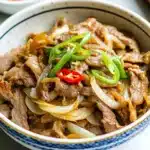
Gyudon (Japanese Beef Rice Bowl) Recipe
- Prep Time: 5 minutes
- Cook Time: 15 minutes
- Total Time: 20 minutes
- Yield: 2 servings
- Category: Main Dish
- Method: Stovetop
- Cuisine: Japanese
Description
Gyudon, a classic Japanese beef rice bowl, features thinly sliced beef and onions simmered in a savory dashi-based sauce with sake, mirin, soy sauce, and sugar. Served over steaming Japanese short-grain rice and garnished with pickled red ginger and green onions, this comforting dish blends sweet and umami flavors for a quick and satisfying meal.
Ingredients
Main Ingredients
- 1/2 onion (4 oz, 113 g), thinly sliced
- 1 green onion/scallion, thinly sliced diagonally
- 1/2 lb (225 g) thinly sliced beef (such as ribeye), cut into 3 inch (7.6 cm) pieces
Sauce
- 1/2 cup dashi (Japanese soup stock)
- 2 Tbsp sake (or dry sherry, Chinese rice wine, or water for non-alcohol version)
- 2 Tbsp mirin (or 2 Tbsp sake/water + 2 tsp sugar)
- 3 Tbsp soy sauce
- 1 Tbsp sugar (adjust to taste)
For Serving
- 2 servings cooked Japanese short-grain rice (approx. 1 2/3 cups / 250 g per serving)
- Pickled red ginger (beni shoga or kizami beni shoga) for garnish
Instructions
- Prepare Ingredients: Thinly slice ½ onion. Cut 1 green onion diagonally into thin slices and set aside. Partially freeze the beef for 10 minutes, then cut into 3-inch wide pieces.
- Combine Sauce Ingredients: In a large frying pan (unheated), combine ½ cup dashi, 2 Tbsp sake, 2 Tbsp mirin, 3 Tbsp soy sauce, and 1 Tbsp sugar. Stir well to dissolve the sugar and blend the sauce.
- Add Onions: Add the sliced onions to the pan, spreading them evenly and separating the layers so they cook uniformly in the sauce.
- Add Beef: Lay the beef slices over the onions, separating each slice so the meat covers the onions evenly.
- Simmer Covered: Cover the pan with a lid and bring to medium heat. Once simmering, reduce heat to low and cook covered for 3 to 4 minutes.
- Skim Impurities: During simmering, occasionally remove the lid and use a fine-mesh skimmer to skim off any scum or excess fat floating on the surface for a cleaner broth.
- Add Green Onions: Sprinkle the sliced green onions on top, cover again, and cook for an additional minute. Optionally, add beaten eggs now and cook gently until set (refer to Tanindon recipe for details).
- Prepare Rice: Divide cooked Japanese short-grain rice evenly into donburi bowls, approximately 1⅔ cups (250 g) per serving.
- Assemble: Drizzle some pan sauce over rice, top with the beef and onion mixture, and add more sauce as desired.
- Garnish: Garnish with pickled red ginger and serve immediately.
Notes
- If you prefer a variation, try the Kansai Sukiyaki-style method by stir-frying onions in oil first, then adding beef, sugar, and cooking with sake, mirin, and soy sauce until the beef is cooked. Optionally, drizzle beaten eggs onto the beef and cook covered until just set before serving over rice.
- Freezing the beef slightly makes it easier to cut thin slices evenly.
- Leftovers can be stored in an airtight container in the refrigerator for 2-3 days or frozen for 3-4 weeks.
- Use a fine-mesh skimmer to improve the clarity and taste of the simmering broth.
- You can substitute sake with dry sherry or Chinese rice wine, or use water if avoiding alcohol.

